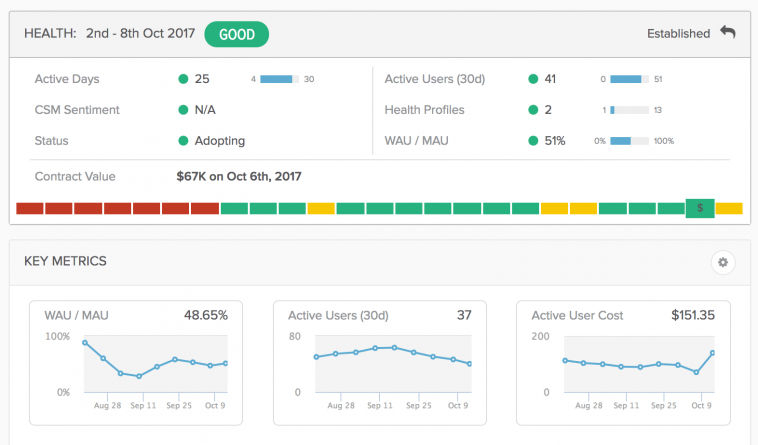- Like
- SHARE
- Digg
- Del
- Tumblr
- VKontakte
- Flattr
- Buffer
- Love This
- Save
- Odnoklassniki
- Meneame
- Blogger
- Amazon
- Yahoo Mail
- Gmail
- AOL
- Newsvine
- HackerNews
- Evernote
- MySpace
- Mail.ru
- Viadeo
- Line
- Comments
- Yummly
- SMS
- Viber
- Telegram
- JOIN
- Skype
- Facebook Messenger
- Kakao
- LiveJournal
- Yammer
- Edgar
- Fintel
- Mix
- Instapaper
- Copy Link
What is a Customer Health Score?
A customer’s health score can be composed of all the information the company has about the customer, from all probes, people, and systems, past and current. A customer health score takes multiple dimensions of customer data metrics and classifies them into a single representation of green, yellow, or red.
Companies measure customer health to speed up and scale communication, prioritization, decision making, and forecasting of their customer success operations. The scorecard model is simple to understand:
When your customer is green, the customer is getting value from the products and services, the engagement is effective and the company should continue to manage the customer in a similar way.
When a customer is marked as red, there is something wrong that requires immediate attention. The customer is not getting the value they anticipated and/or there is poor engagement with the account. Immediate action is required to remedy the issues at hand.
Customer health is one of the key components of an early warning system.
What Can Customer Health Scores Measure?
Customer health scores can measure nearly all of your interactions with your customers when determining your score. The most common health categories are:
- Product Usage and Adoption – what are the volume and depth of use?
- License Utilization – what percentage of the sold licenses and services are actually being utilized?
- Business Results – is the customer getting the value they signed up for?
- Engagement – support, billing, marketing, customer success engagements – how are those going?
- Advocacy – is this customer a brand advocate?
- Customer Satisfaction- are you getting feedback from customers in the form of CSAT, CSM sentiment and satisfaction scores?
Health Scorecard
Tying all these metrics together, the health formula can produce three different types of results:
- Green Customer – All of the thresholds of usage, utilization, business results, engagement and advocacy are met.
- Red Customer – The customer is flagged in at least one of those categories. There could be a sharp decline is usage or the customer is a detractor or not paying their bills and so forth. I’m sure you get the point.
- Yellow Customer – They only meet some of the green criteria but not all of them. So there is clear room for improvement, but on the other hand, nothing is burning (yet).
With this model of a health formula, you have the ability to color each customer and can easily communicate the reasoning behind the health classification.
Rule-Based Customer Health vs. Linear-Based Customer Health
Using logical conditions is also known as Rule-Based Customer Health. Most people start with customer health using a spreadsheet. They use excel formulas to summarize the metrics across a row and come up with a number. This is known as linear-based health.
Linear-based health has a few known limitations compared to rule-based customer health:
- Masking – It is very easy to understand a customer score of 100 (all good) or 0 (all bad), but it becomes very difficult to understand the issues revolving around a customer score of 30 to 70.
- Difficult to Change – formula change in linear health is very difficult to do and in many cases creates confusion
The intuitive value of rule-based customer health is clear, it’s a more accurate decision-making process to be proactive about customer operations.
If you find this topic relevant for you, watch our customer health webinar series video-on-demand:
Watch Part 1 “How to Build an Effective Customer Health Model” with Totango + iPerceptions
Watch Part 2 – “Measuring the Effectiveness of a Customer Health Model” with Totango + Feedvisor
The Totango Spark platform provides all the tools you need to easily determine what is your client’s health score. Try it free to start calculating health scores today.




